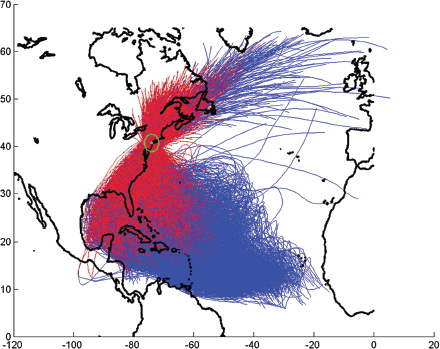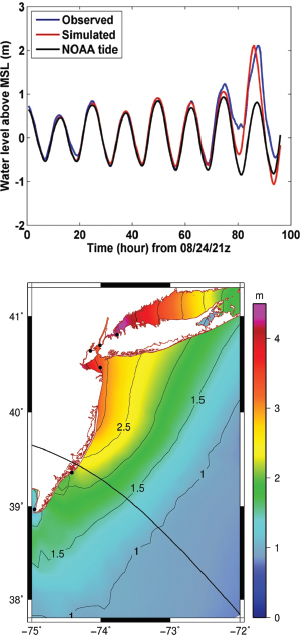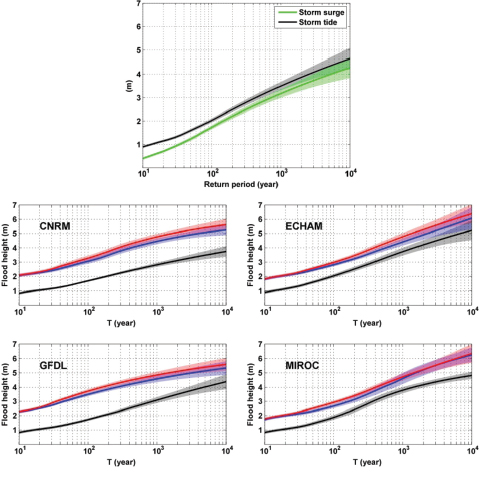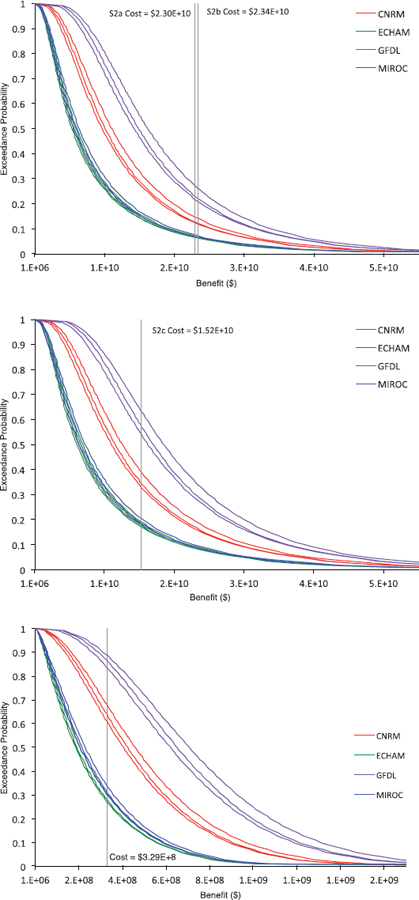An Integrated Approach to Assess and Manage Hurricane Risk in a Changing Climate
Hurricanes, with their strong winds, heavy rainfall, and storm surges, cause much damage and loss of life worldwide. Recent disasters, such as Hurricanes Katrina in 2005 and Sandy in 2012, Cyclone Nargis in 2008, and Typhoon Haiyan in 2013, underscore the significant vulnerability of the United States and the world to landfalling hurricanes. Furthermore the impacts of these storms may worsen in the coming decades because of rapid coastal development coupled with sea-level rise and possibly increasing hurricane activity due to climate change.
Major advances in hurricane risk management are urgently needed. Given the inherent uncertainties in hurricane activity, such management should be strongly informed by probabilistic risk assessment. Furthermore, hurricane risk assessment cannot rely solely on historical records: to account for projected future changes, it should integrate physical knowledge and models with observational data.
INTRODUCTION
A physically based probabilistic hurricane risk assessment framework should integrate analysis of storm activity, hazards, and risk. Because of the limitations of historical records and the complexity of the problem, Monte Carlo (MC) methods, based on numerous synthetic simulations, are often used.
In an MC approach, large numbers of synthetic but physically possible storms, characterized by their track, intensity, and size, are simulated (with their annual frequencies estimated) under observed or climate model–simulated climate conditions. Hazard models are then used to estimate the wind, surge, and rainfall-induced flooding associated with the simulated storms.
Given the estimated hazards and coastal exposure, vulnerability models can be applied to estimate storm-induced consequences (e.g., damage and/or economic losses) and thus risk. The risk assessment can in turn inform risk management.
The following sections review the main components—hurricane activity, hazards, and risk—of a physically based hurricane risk assessment framework and its application to evaluating risk mitigation strategies.
HURRICANE ACTIVITY
Various MC methods have been developed to simulate storms that depict hurricane activity and climatology. Most of these methods (e.g., Hall and Sobel 2013; Toro et al. 2010; Vickery et al. 2000) create simulations based on the statistics of the historical storm records.
In my laboratory we apply the statistical-deterministic model developed by Emanuel and colleagues (2006, 2008). It simulates storm environments statistically but generates synthetic storms deterministically (with physical models). The large samples of synthetic storms generated by the model are in statistical agreement with the (albeit limited) observations. Moreover, as the synthetic hurricane environments can be generated for any given climate state, the model can simulate storms not only in current and past climates but also in projected future climates.
This model has been used to simulate storms in various ocean basins under projected climates over the 21st century to investigate how storm intensity and frequency may change with the changing climate (Emanuel 2013). It has also been used to simulate storms at city scales—for New York City (NYC; Lin et al. 2010a, 2012; Reed et al. 2015); Miami (Klima et al. 2011), Apalachee Bay (Lin et al. 2014), and Tampa (Lin and Emanuel 2015) in Florida; Galveston, Texas (Lickley et al. 2014); Cairns, Australia (Lin and Emanuel 2015); and Dubai in the Persian Gulf (Lin and Emanuel 2015). As an illustration, Figure 1 shows a sample of 5,000 storms simulated for NYC. These city-scale simulations can be used to analyze local hazards and risk.
HURRICANE HAZARDS
Given a storm’s characteristics, hazard models can be applied to estimate the wind, surge, and rainfall-induced flooding during the storm’s landfall. Because large numbers of simulations are required for the MC-based risk analysis, the hazard models should be (computationally) “simple” (often there is a balance between accuracy and efficiency).
Wind
Various simple parametric methods have been developed to model the wind. In such an approach, one estimates the storm wind field using a parametric wind

FIGURE 1 Simulation, using the Emanuel et al. (2006) model, of 5,000 synthetic storms that pass within 200 km of the Battery in New York City with a maximum wind speed greater than 21 m/s, under the observed climate of 1981–2000 and with an estimated annual frequency of 0.34. The green circle shows the 200 km radius around the Battery. Each blue curve shows a storm track, and the red portion of each track shows the 100-hour period before and during landfall (the main time period considered for hazard modeling). Longitude and latitude are shown on the axes. Figure in color at http://www.nap.edu/catalog/21825.
profile (e.g., Holland 1980; Jelesnianski et al. 1992) and adds an estimated background wind (Lin and Chavas 2012) to obtain the total wind field. My lab has recently developed a new wind profile (Chavas et al. 2015), motivated by the physical understanding that the canonical wind fields of mature hurricanes, although approximately circularly symmetric, cannot be described by a single mechanism.
Emanuel (2004) developed a physical model of the outer nonconvecting region of the storm, and Emanuel and Rotunno (2011) established an analytical profile that is physically valid only for the inner convecting region. We mathematically merged these two theoretical solutions to develop a complete wind profile for the entire domain of the storm (Chavas et al. 2015). This new physical model, evaluated and calibrated with various observational datasets, will have broad applications in hurricane hazard analysis.
Storm Surges
Storm surges, driven mainly by the storm surface wind and pressure, are also sensitive to coastal bathymetry and topography. Hydrodynamic surge models, basically solving coastal shallow water equations, include the SLOSH (Sea, Lake, and Overland Surges from Hurricanes) model (Jelesnianski et al. 1992), used by the National Hurricane Center for real-time forecasting, and the Advanced Circulation (ADCIRC) model (Westerink et al. 2008). The SLOSH model is computationally more efficient, but the ADCIRC model can better resolve the physical processes and produce results with higher resolutions.
Both the SLOSH and ADCIRC models are applied in my lab, depending on applications. Figure 2 shows that, as an example, the simulated storm surges in the NYC area from Hurricanes Irene (2011) and Sandy, using the ADCIRC model in this case, compare very well with the tidal gauge observations. In these simulations, we used high-resolution bathymetry and topography data, observed storm characteristics, as well as our new complete wind profile (Chavas et al. 2015) and a simple parametric pressure model (Holland 1980).
Rainfall
Hurricane rainfall is comparatively difficult to model because of its large spatial and temporal variation. Thus, most hurricane rainfall modeling applies full numerical weather prediction models (e.g., Lin et al. 2010b; Tuleya and DeMaria 2007). However, this approach requires large quantities of input data and has a high computational cost, so it is not effective for risk analysis.
Recently, simpler parametric models have been developed based on historical rainfall statistics (e.g., Lonfat et al. 2007; Tuleya et al. 2007) and physical principles (e.g., Langousis and Veneziano 2009). The basic physics of hurricane rainfall is that it is determined mainly by the combination of environmental moisture and the speed of the storm updraft. The latter depends on low-level convergence due to surface friction, storm intensification, interactions with topography, and the background baroclinic state. A model that describes these processes has been shown to generate rainfall statistics comparable to the observations (Zhu et al. 2013).
Research in my lab is ongoing to evaluate and further develop this physical rainfall model, which can then be coupled with a hydrologic model (e.g., Cunha et al. 2012) to simulate inland flooding.
HURRICANE RISK
Hazard models can be applied to simulated synthetic storms to generate large samples of hazards from which hazard probabilities can be estimated. For example, the ASCE building code has used such an approach to establish design wind maps (showing wind speeds for various return periods) for the entire US

FIGURE 2 Storm surge estimation for New York City for Hurricanes Irene (above; time series of water level at the Battery) and Sandy (below; spatial distribution of the simulated peak surge; the estimated peak surge at the Battery, about 2.9 m, is close to the observed value of about 2.8 m above high tide; black curve shows the track of Sandy). Figure in color at http://www.nap.edu/catalog/21825. MSL = mean sea level; NOAA = National Oceanic and Atmospheric Administration.
coast. Similarly, the Federal Emergency Management Agency (FEMA) developed flood maps depicting 100- and 500-year floodplains as a basis for the federal flood insurance policy. (Different storm and hazard models were used in these different applications.)
If the hurricane model used to generate synthetic storms draws on climate model–projected climate environments (Emanuel et al. 2008), then one can estimate probabilistic hazards under future climates. We have performed such analysis for various coastal cities; for example, Figure 3 shows our estimations of the storm surge level for NYC as a function of return period, under the observed current climate as well as climate model–estimated current climates and climate model–projected future climates. The results indicate a potentially significant increase of surge floods in the future due to climate change.
The hazard probabilities can also be combined with the estimated consequences of the hazards to quantify the risk. (The consequent damage/losses can be estimated with vulnerability models such as the Hazus model developed by FEMA.) The risk is often expressed by the expectation (mean) of the loss in a year (e.g., Aerts et al. 2013), but the full probabilistic distribution of the loss, if available, is more informative. In the context of climate change and coastal development, this risk is likely increasing.
To obtain a temporally integrated measure, the overall loss is also typically quantified by its present value (PV), the sum of all discounted losses occurring over a given time horizon (e.g., the next 100 years). Then the risk can be considered as the mean or, better, the probability distribution of the PV of future losses.
BENEFITS AND COSTS OF RISK MITIGATION STRATEGIES
The PV also provides a convenient metric for comparing the benefit and cost of risk mitigation strategies. The benefit can be considered as the PV of the future losses prevented by mitigation, and the cost is the PV of the total cost of the mitigation (including construction and maintenance). While the cost is largely deterministic, the benefit is random.
Most studies have focused on comparing the cost and the mean of the benefit (e.g., Aerts et al. 2014). We present a more informative probabilistic cost-benefit analysis, applied to various coastal flood mitigation strategies proposed for NYC. As shown in Figure 4, for each strategy we estimate the full probability distribution of the benefit and plot its exceedance probability function to compare with the cost. The crossing of the curve of the benefit exceedance probability and the line showing the cost indicates the probability that the benefit is greater than the cost. The probabilities of getting any higher or lower benefits can also be easily read from the curve.
The probabilistic benefit-cost analysis thus provides adequate information for making management decisions for any specific risk tolerance (decisions made based on the mean implicitly assume “risk neutral”). Also, this risk management

FIGURE 3 Estimated storm surge return level curves for New York City, under (top) the observed climate of 1980–2000 and (below) four climate model–estimated climates for 1980–2000 (black) and 2080–2100 (blue and, when accounting also for potential changes in storm size, red; with projected 1 meter sea level rise accounted for). Each curve is based on 5,000 synthetic storms (e.g., the curves in the top panel are based on the 5,000 storms shown in Figure 1). Four climate models are applied: CNRM (CNRM-CM3; Centre National de Recherches Météorologiques, Météo-France), ECHAM (ECHAM5; Max Planck Institute), GFDL (GFDL-CM2.0; NOAA/Geophysical Fluid Dynamics Laboratory), and MIROC (MIROC3.2, Model for Interdisciplinary Research on Climate; University of Tokyo Center for Climate System Research (CCSR)/National Institute for Environmental Studies (NIES; Japan)/Frontier Research Center for Global Chance (FRCGC), Japan Agency for Marine-Earth Science and Technology (JAMSTEC)). Figure in color at http://www.nap.edu/catalog/21825. SOURCE: Lin et al. (2012).

FIGURE 4 Estimated exceedance probability of the benefit (curve) compared to the cost (vertical line) for strategies S2a and S2b (top), strategy S2c (middle), and a strategy of elevating new houses on the floodplain by 6 feet (bottom) for New York City (NYC). S2a consists of three barriers to close off parts of NYC and New Jersey but preserves wetland dynamics of Jamaica Bay. S2b expands on S2a by adding a fourth barrier that closes off Jamaica Bay. S2c replaces three barriers from S2b with one large barrier in the outer NY harbor to protect a larger area. The details of these mitigation strategies are discussed in Aerts et al. (2014). The analyses account for projected coastal development and changes in storm activity and sea level over the 21st century. Current and future building stock data are obtained from the NYC Office of Emergency Management. Synthetic storm surge events are obtained from Lin et al. (2012) for the four climate models (CNRM, ECHAM, GFDL, and MIROC; see Figure 3 for definitions), as shown by the return level curves in Figure 3. The probabilistic sea level rise projection is based on Kopp et al. (2014); the three curves of the same color show results with sea level rise projected for the three IPCC AR5 (Intergovernmental Panel on Climate Change Fifth Assessment Report) emission scenarios (RCP 2.6, RCP 4.5, and RCP 8.5). Figure in color at http://www.nap.edu/catalog/21825.
analysis has relied on the physically based risk assessment to account for the dynamic evolution of urban development, storm climatology change, and sea level rise.
FUTURE RESEARCH
Although much remains unknown about how hurricanes, especially their frequency and size, will vary with the climate, risk assessment should continue to incorporate the state-of-the-art science to support risk management. Effective risk analysis will require more physical or physical-statistical methods for simulating synthetic storms. Hurricane rainfall models, especially those based on physics, need to be developed to estimate inland flood risk in a changing climate. Hurricane hazards are correlated (e.g., hurricane wind affects both storm surge and rainfall; coastal and inland flooding may interact), and multihazard approaches are needed to estimate how hazards will jointly evolve and how to deal with the joint risk.
In addition to engineering measures, urban planning and federal and private insurance play increasingly important roles in coastal risk mitigation. Establishing systematic and more integrated strategies may be the future direction for hurricane risk management.
ACKNOWLEDGMENT
The author acknowledges the support of National Science Foundation grant EAR-1520683.
REFERENCES
Aerts JC, Lin N, Botzen W, Emanuel K, de Moel H. 2013. Low-probability flood risk modeling for New York City. Risk Analysis 33(5):772–788.
Aerts JCJH, Botzen WJW, Emanuel K, Lin N, de Moel H, Michel-Kerjan EO. 2014. Evaluating flood resilience strategies for coastal megacities. Science 344(6183):473– 475.
Chavas DR, Lin N, Emanuel K. 2015. A model for the complete radial structure of the tropical cyclone wind field. Part I: Comparison with observed structure. Journal of the Atmospheric Sciences 72(9):3647–3662.
Cunha LK, Mandapaka PV, Krajewski WF, Mantilla R, Bradley A. 2012. Impact of radar-rainfall error structure on estimated flood magnitude across scales: An investigation based on a parsimonious distributed hydrological model. Water Resources Research 48(10).
Emanuel K. 2004. Tropical cyclone energetics and structure. In: Atmospheric Turbulence and Mesoscale Meteorology, ed. Fedorovich E, Rotunno R, Stevens B. Cambridge, UK: Cambridge University Press. pp. 165–192.
Emanuel KA. 2013. Downscaling CMIP5 climate models shows increased tropical cyclone activity over the 21st century. Proceedings of the National Academy of Sciences 110(30):12,219–12,224.
Emanuel K, Rotunno R. 2011. Self-stratification of tropical cyclone outflow. Part I: Implications for storm structure. Journal of the Atmospheric Sciences 68:2236–2249.
Emanuel K, Ravela S, Vivant E, Risi C. 2006. A statistical deterministic approach to hurricane risk assessment. Bulletin of the American Meteorological Society 87:299–314.
Emanuel K, Sundararajan R, Williams J. 2008. Hurricanes and global warming: Results from down-scaling IPCC AR4 simulations. Bulletin of the American Meteorological Society 89:347–367.
Hall TM, Sobel AH. 2013. On the impact angle of Hurricane Sandy’s New Jersey landfall. Geophysical Research Letters 40(10):2312–2315.
Holland GJ. 1980. An analytic model of the wind and pressure profiles in hurricanes. Monthly Weather Review 108(8):1212–1218.
Jelesnianski CP, Chen J, Shaffer WA. 1992. SLOSH: Sea, lake, and overland surges from hurricanes. NOAA Technical Report NWS 48. Silver Spring, MD: National Weather Service, National Oceanic and Atmospheric Administration.
Klima K, Lin N, Emanuel K, Morgan MG, Grossmann I. 2011. Hurricane modification and adaptation in Miami-Dade County, Florida. Environmental Science and Technology 46:636 – 642.
Kopp RE, Horton RM, Little CM, Mitrovica JX, Oppenheimer M, Rasmussen DJ, Strauss BH, Tebaldi C. 2014. Probabilistic 21st and 22nd century sea-level projections at a global network of tide-gauge sites. Earth’s Future 2:383 – 406.
Langousis A, Veneziano D. 2009. Theoretical model of rainfall in tropical cyclones for the assessment of long-term risk. Journal of Geophysical Research 114:D02106.
Lickley MJ, Lin N, Jacoby HD. 2014. Analysis of coastal protection under rising flood risk. Climate Risk Management 6:18–26.
Lin N, Chavas D. 2012. On hurricane parametric wind and applications in storm surge modeling. Journal of Geophysical Research 117:D09120.
Lin N, Emanuel K. 2015. Grey swan tropical cyclones. Nature Climate Change. doi:10.1038/nclimate2777.
Lin N, Emanuel KA, Smith JA, Vanmarcke E. 2010a. Risk assessment of hurricane storm surge for New York City. Journal of Geophysical Research 115:D18121.
Lin N, Smith JA, Villarini G, Marchok TP, Baeck ML. 2010b. Modeling extreme rainfall, winds, and surge from Hurricane Isabel (2003). Weather and Forecasting 25:1342–1361.
Lin N, Emanuel K, Oppenheimer M, Vanmarcke E. 2012. Physically based assessment of hurricane surge threat under climate change. Nature Climate Change 2:1–6.
Lin N, Lane P, Emanuel KA, Sullivan RM, Donnelly JP. 2014. Heightened hurricane surge risk in northwest Florida revealed from climatological-hydrodynamic modeling and paleorecord reconstruction. Journal of Geophysical Research: Atmospheres 119(14):8606 – 8623.
Lonfat M, Rogers R, Marchok T, Marks FD Jr. 2007. A parametric model for predicting hurricane rainfall. Monthly Weather Review 135:3086–3097.
Reed AJ, Mann ME, Emanuel KA, Lin N, Horton BP, Kemp AD, Donnelly JP. 2015. Increased threat of tropical cyclones and coastal flooding to New York City during the anthropogenic era. Proceedings of the National Academy of Sciences 112(41):12610–12615.
Toro GR, Resio DT, Divoky D, Niedoroda AW, Reed C. 2010. Efficient joint-probability methods for hurricane surge frequency analysis. Ocean Engineering 37(1):125–134.
Tuleya RE, DeMaria M. 2007. Evaluation of GFDL and simple statistical model rainfall forecasts for US landfalling tropical storms. Weather and Forecasting 22:56–70.
Vickery P, Skerlj P, Twisdale L. 2000. Simulation of hurricane risk in the US using empirical track model. Journal of Structural Engineering 126(10):1222–1237.
Westerink JJ, Luettich RA, Feyen JC, Atkinson JH, Dawson C, Roberts HJ, Powell MD, Dunion JP, Kubatko EJ, Pourtaheri H. 2008. A basin- to channel-scale unstructured grid hurricane storm surge model applied to southern Louisiana. Monthly Weather Review 136:833–864.
Zhu L, Quiring SM, Emanuel KA. 2013. Estimating tropical cyclone precipitation risk in Texas. Geophysical Research Letters 40:6225–6230.
This page intentionally left blank.












